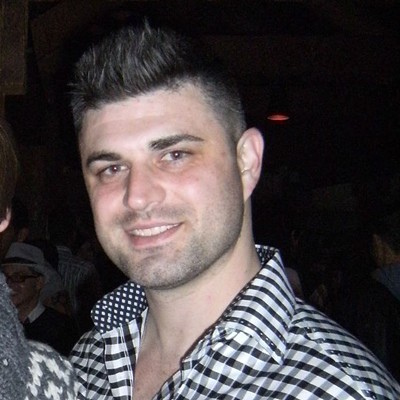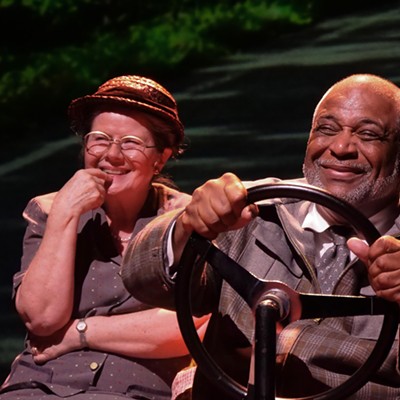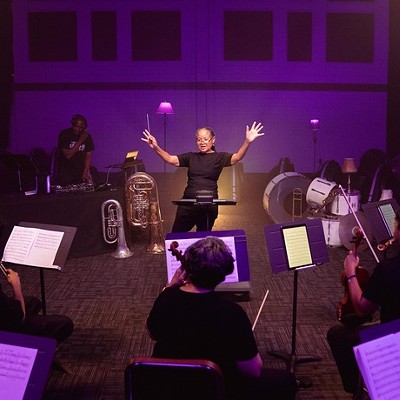Discussing HIV/AIDS is never a fun matter, but it’s a serious one. So this week, in honor of World AIDS Day on December 1, we’ve decided to speak bravely about the disease as well as detail a list of resources for education, testing and support. Grab a snack, because this is going to be a long one…
According to
AIDS.gov, the illness first made its presence known around the early 1980s in Los Angeles. Doctors didn’t have a name for it. They just noticed it to be predominant among gay men, so it earned the nickname “gay cancer.”
By 1982, the Centers for Disease Control and Prevention (CDC) was using the term AIDS, standing for Acquired Immune Deficiency Syndrome, in reference to the disease's ability to disable the body’s immune system. By December 10 of the same year, the CDC reported a case of AIDS in an infant who had received blood transfusions.
Tension was high and fear was rampant. No one quite knew how the disease was transmitted. It wasn’t until 1983 that the CDC identified all major routes of HIV transmission and thereby eliminated the speculation that it could be transmitted by casual contact, food, water, air or environmental surfaces.
Later that same year, the World Health Organization held its first meeting to assess the global AIDS situation and begin its surveillance of the epidemic.
In 1985, we saw a hemophiliac teenager named Ryan White be denied entry to a public school because he had contracted AIDS from his necessary blood transfusions. This wouldn’t be the last time we heard his name.
His struggle to erase the stigma of the disease would later merit him the titular Ryan White Comprehensive AIDS Resources Emergency (CARE) Act of 1990, which provided $220.5 million in federal funds for HIV community-based care and treatment services in its first year.
It took until 1985 for President Ronald Reagan to mention AIDS publicly, which still causes an emotional reaction among people who lived through the 1980s and watched many of their friends die from this still-mysterious disease.
Shortly thereafter, Rock Hudson passed away from an AIDS-related illness – the first major figure to acknowledge he was living with the illness. Then we lost Liberace. Then, Freddie Mercury. Sadly, the list goes on.
By 1987, Cleve Jones was creating the first panel for the AIDS Memorial Quilt. According to the
AIDS Quilt website, the quilt had humble beginnings. A small group gathered in San Francisco to document the lives they feared history would neglect. Their goal was to create a memorial for those who had died of AIDS, and thereby to help people understand the devastating impact of the disease.
Today the quilt is a powerful visual reminder of the AIDS pandemic. More than 48,000 individual three-foot-by-six-foot memorial panels — most commemorating the life of someone who has died of AIDS — have been sewn together by friends, lovers and family members.
The AIDS Memorial Quilt first went on display on the National Mall in Washington, DC, featuring 1,920 panels, and it drew more than half a million visitors.
By 1988, World AIDS Day was observed for the first time, designated by the World Health Organization (WHO) and under the support of the United Nations.
By 1992, there seemed to be a glimmer of hope for combating the disease. The U.S. Food and Drug Administration licensed a rapid HIV diagnostic test kit that gave results from a blood test in ten minutes.
Tony Kushner’s play about AIDS,
Angels in America, won the Pulitzer Prize.
The U.S Food and Drug Administration approved the female condom. Finally, women on top!
Tom Hanks starred in the movie
Philadelphia, in which he portrayed a lawyer fired from his job because of his HIV-positive status. The role earned him the Academy Award.
Soon after, MTV cast
The Real World, and we meet Pedro Zamora. The reality star lived his life publicly open about his HIV-positive status.
The musical
RENT showed us the everyday struggles of people living with HIV.
For anyone who wasn’t aware about the disease, the stream of pop culture busted the door down and made the topic of HIV part of our regular vernacular.
The disease had new treatments as well. Zidovudine, an antiretroviral drug regularly known as AZT, was in widespread use for HIV patients, thereby extending their life expectancy.
But there were some downfalls, too, during that era.
President Clinton signed an HIV immigration policy into law. It would last until the Obama administration, when it would be officially omitted. To add insult to injury, the CDC added three new conditions to the list of clinical indicators of AIDS, meaning more women and people who inject drugs would be diagnosed with AIDS.
The AIDS epidemic peaked in the 1990s, and lasted through the end of the decade. As of the end of 2000, 774,467 persons had been reported with AIDS in the United States; 448,060 of them had died and 3,542 persons had unknown vital status. The number of persons living with AIDS is the highest ever reported. Of these, 79 percent were men, 61 percent were black or Hispanic, and 41% were infected through male-to-male sex.
It wasn’t just an American disease either. After all, it is called
World AIDS Day for a reason. It has affected everyone. It’s a nondiscriminatory illness that has changed people's lives regardless of age, religion, ethnicity, race, monetary status and every other description we can fathom.
WHO reported in 1999 that an estimated 33 million people were living with HIV, and that 14 million had died from AIDS. The organization labeled it the fourth-biggest cause of death worldwide and the number cause of death in Africa.
But the people infected with the disease marched on with the desire for a better outcome. And, gladly, so did the people in charge. In 2000, President Clinton announced an initiative to create incentives for developing and distributing vaccines against the virus. UNAIDS, WHO and other global groups announced a joint initiative with major pharmaceutical manufacturers to reduce prices for HIV/AIDS drugs in developing countries.
In 2005, former South African president Nelson Mandela announced that his son Makgatho had died from AIDS. He urged people not to think of AIDS as a curse but rather as an ordinary disease. Mandela’s attempt to erase the stigma of living with HIV/AIDS would soon be met worldwide.
New drugs, like Truvada, were introduced to the market and made readily available to people who were considered high-risk targets for transmission. Pre-exposure prophylaxis (PreP) has shown a success rate well into the 90th percentile for stopping the spread of HIV to sexual partners.
At the same time, we as a community have become more open and accepting toward our brothers and sisters who are living with HIV. We’ve come to know more about the illness, and we’ve come to answer Mandela’s call for erasing the stigma of the disease.
So where does that leave us? We’ve survived the destruction of the disease thus far, but the job isn’t done yet. We’ve still got a long way to go toward raising awareness and encouraging testing and treatment for the disease.
Lucky for us, World AIDS Day is the perfect opportunity to jump on board and take advantage of many of the services available to us. Here's a look at some of the biggest events happening around town for testing, raising money for HIV-focused charities or simply taking a moment to reflect on those who have passed away from AIDS-related illnesses.
Let’s start with the swankiest blowout for World AIDS Day:
World AIDS Day Luncheon
December 1, 11 a.m.—1 p.m.
Hilton Houston Post Oak, 2001 Post Oak Boulevard
AIDS Foundation Houston, with the support of the hosts, local television royalty Ernie Manouse and real estate guru Bill Baldwin, will entertain guests for a luncheon. This year’s keynote speaker will be author, founder of
POZ magazine and activist Sean Strub. This year’s event is largely supported by Chevron.
He will also be available at Brazos Bookstore as part of the World AIDS Day commemoration. He will autograph his book, which is available for purchase at the store.
Strub plans to educate the gatherers about the impact of HIV and how to make a difference.
Regarding the theme of his talk, he says, “It’s about stigma. We’ve made incredibly dramatic advances in treatment and on the biomedical side of the disease. Stigma, though, is worse today than it’s ever been. Most people remember or have heard about people who wouldn’t shake hands or go to a gay restaurant because they were afraid. Stigma is about people making immoral judgments on others’ worth when they find out about someone’s HIV status, and it’s also about internal stigma for people living with HIV.”
Funds will support the foundation’s efforts to battle HIV/AIDS as well as serve as a good reason for people to gather for a scrumptious lunch. Tickets start at at $150 per person and can be purchased at
aidshelp.org.
He adds, “We think that because medical treatment is great that the stigma has gone away, but it hasn’t. It prevents people from getting tested and getting treatment.”
We agree with Strub. Testing and knowledge both lead to power. If you can’t attend the luncheon, there is a bevy of other ways to get tested for World AIDS Day. See more below:
Houston Campus Takeover
December 1, 11 a.m.–2 p.m.
Houston-area college campuses
Houston Area Community Services and Bering Omega, both community-minded organizations, have joined forces under a new name — Avenue 360. With the same forward-thinking spirit and quality care in place, the organization is focusing on testing with the younger generation for 2016’s holiday season. Avenue 360 will offer a free rapid HIV test as well as provide safer-sex education at various Houston college campuses.
Get your test on at Houston Community College – Southeast Campus, Lone Star College – North Harris Campus, Lone Star College – Victory Center, Lone Star College – Greenspoint Center, Texas Southern University, and University of Houston.
World AIDS Day Prayer Vigil
December 1, 12–1 p.m.
Resurrection Metropolitan Community Church, 2025 West 11th Street
In solidarity with others around the world, the church offers a chance to come together to remember all of our loved ones who have passed on from complications of HIV/AIDS and provide an opportunity for us to witness our solidarity with those who are living with HIV/AIDS and for their caregivers who extend compassionate care. Guests can unite in the call and advocacy of breaking free from this disease.
Twilight Meditation for World AIDS Day
December 1, 6 p.m.
Rothko Chapel, 3900 Yupon
Partake in a twilight meditation, offered in partnership with Avenue 360 Health and Wellness. Show support and solidarity with the millions of people living with and affected by HIV/AIDS.
Pharmacy technician Robert Munoz, of Avenue 360 Health and Wellness, will begin the event by sharing some important facts on the history and current state of the HIV/AIDS pandemic. A guided meditation led by local meditation facilitator Gabriel Clark will follow. The program will end with a reception on the chapel’s plaza.
World AIDS Day Vigil
December 1, 6–7 p.m.
Legacy Community Health – Montrose, 1415 California
There will be a brief program with guest speakers, followed by a reading of names and a walking candlelight vigil. If you have names you would like to honor and remember, please send them to
[email protected] for the reading.
World AIDS Day Vigil
December 1, 6:30–8 p.m.
Legacy Community Health – Central Beaumont, 450 North 11th.
Legacy invites everyone to honor the legacy of those we have lost to HIV/AIDS. Hang an ornament on the holiday tree in remembrance of those who lost their lives too soon. Refreshments and a small gift will be provided to those who RSVP. Please email
[email protected] or call 409-242-2618 to register.
Cheers To HIV Awareness!
Guava Lamp World AIDS Day Event, Featuring Gabe LaDuke
December 1, 7 – 11 p.m.
570 Waugh Drive
Join friends at the local watering hole! Nothing makes the nurse's small prick a little easier to take than treats. The menu includes a special appearance by international male model Gabe LaDuke, along with food, vendors and fun to help raise money to assist those affected by HIV/AIDS and to help prevent new HIV infections. AIDS Foundation Houston will conduct free confidential HIV and syphilis testing. The two like to travel in pairs, so might as well make that blood draw count and get tested for both.
World AIDS Day Film Screening
December 1, 7 p.m.
The Montrose Center, 401 Branard Street
Show support for people living with HIV and commemorate the lives lost at the free film screening of
Parting Glances.
The organization describes the movies as such: In 1985, while the gay community seethed over the Reagan administration's indifference to AIDS, writer-director Bill Sherwood filmed this charmingly quirky piece that gracefully placed a human face on the epidemic. Over the course of 24 hours, lovers Michael (Richard Ganoung) and Robert (John Bolger) emotionally joust as Robert prepares to leave for overseas. A quasi-autobiographical character, Michael confronts his separation anxiety with ironic fortitude as he faces Robert's departure and the illness of his ex-lover and best friend, Nick, vividly played by Steve Buscemi in his breakout role.
World AIDS Day: A Celebration of Life
December 1, 7–8:30 p.m.
Discovery Green, 1500 McKinney
The website’s event listing says the following: “We are faced with a harsh reality that HIV and AIDS still affects Black Houston and the rest of our nation in ways that must be addressed. The issues that center on the lack of knowledge and education in our communities about HIV the virus and AIDS the syndrome, the stigma that comes from that lack of education and the lack of testing in our communities. If we are to proclaim that #BlackLivesMatter, then we must matter to ourselves and on every level.”






